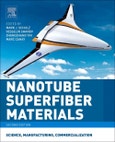Nanotube Superfiber Materials: Science, Manufacturing, Commercialization, Second Edition, helps engineers and entrepreneurs understand the science behind the unique properties of nanotube fiber materials, how to efficiency and safely produce them, and how to transition them into commercial products. Each chapter gives an account of the basic science, manufacturing, properties and commercial potential of a specific nanotube material form and its application. New discoveries and technologies are explained, along with experiences in handing-off the improved materials to industry. This book spans nano-science, nano-manufacturing, and the commercialization of nanotube superfiber materials. As such, it opens up the vast commercial potential of nanotube superfiber materials.
Applications for nanotube superfiber materials cut across most of the fields of engineering, including spacecraft, automobiles, drones, hyperloop tracks, water and air filters, infrastructure, wind energy, composites, and medicine where nanotube materials enable development of tiny machines that can work inside our bodies to diagnose and treat disease.
Please Note: This is an On Demand product, delivery may take up to 11 working days after payment has been received.
Table of Contents
1. NNI 2.0 Future Directions and Opportunities under the National Nanotechnology Initiative
Part 1. Sensors and Devices 2. Nanotubes for Sensing 3. Sheath-Core Conducting Fibers for Weavable Superelastic Wires, Biosensors, Supercapacitors, Strain Sensors, and Artificial Muscles 4. Creation of CNT junctions for 3D structures and virus isolation using VA-CNTs 5. Science and Application of sp2-Bonded Nanomaterials 6. Nanostructured Cathode and Anode Materials for Vacuum Electronic Devices 7. Nano-Imprint Lithography for Tiny Devices 8. Nanotube Fiber Sensors for Heavy Metals in Liquids
Part 2. Composite Materials and Textiles 9. Nanotubes are Not the Only Carbon 10. Strain Measurement and Damage Detection using Integrated Carbon Nanotube Yarn Sensors 11. CNT/CF hybrid composites 12. 3D Textile and Foam Structures Enhanced by Aligned Carbon Nanotube Sheets 13. CNT Sheet for Multi-Purpose Composite Materials and Textiles 14. Wearable NanoSensors
Part 3. Electrical Conductors and Electronics 15. Ultrawire new electrical conductor 16. Carbon Nanotube Electrical Conductors 17. Conductivity Mechanisms in CNT Yarns 18. Electromagnetic Simulation and Measurement of Carbon Nanotube Thread and Sheet Antennas 19. Development of Long Length Electrical Conductors Incorporating Nanotechnology: Carbon-Based and Superconducting 20. Electrical Conduction in Cu-Carbon Nanotube Fibers 21. Nanomagnetics for Power Applications 22. High Rate Manufacturing of Hybrid Cu-CNT Electrical Conductors
Part 4. Environmental, Biomedical, Thermal, and Space Applications 23. High-efficiency Particulate Air Filters Based on Carbon Nanotubes 24. Water Filtering using Carbon Nanotube Sheets 25. Nanoengineering Materials for Heat Dissipation 26. Carbon Electric Motors 27. Heatable Carbon Nanotube Filters 28. Interplanetary NanoManufacturing Utilizing In-Situ Resources 29. Medical Applications of Nanotube Materials
Part 5. Energy 30. Recent Advances in Boron Nitride Nanotubes: Manufacturing, Chemistry, Composites and Applications 31. Autonomous Research Systems for Carbon Nanotube Synthesis 32. Multidimensional and Multifunctional Graphitic Carbon Nanomaterials for Energy Conversion and Storage 33. Fluidized-Bed Production of Sub-Millimeter-Long Carbon Nanotubes and Their Application to Electrochemical Energy Storage Devices 34. Energy Storage using Graphene and Carbon Nanotubes 35. Graphene: Large scale manufacturing and development of multifunctional materials








